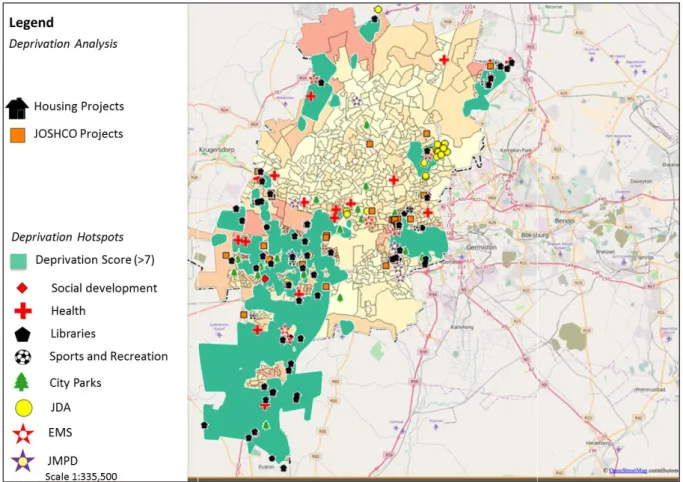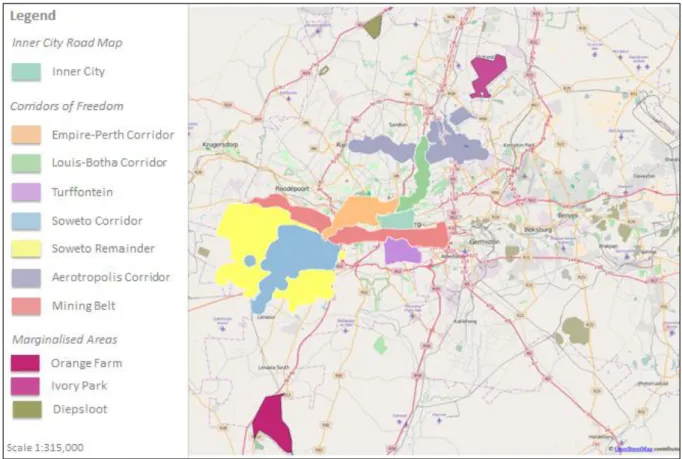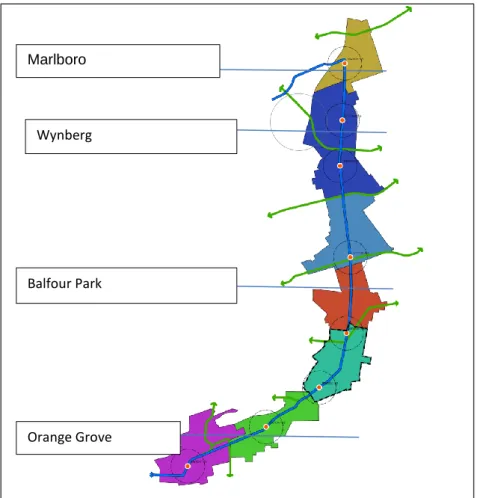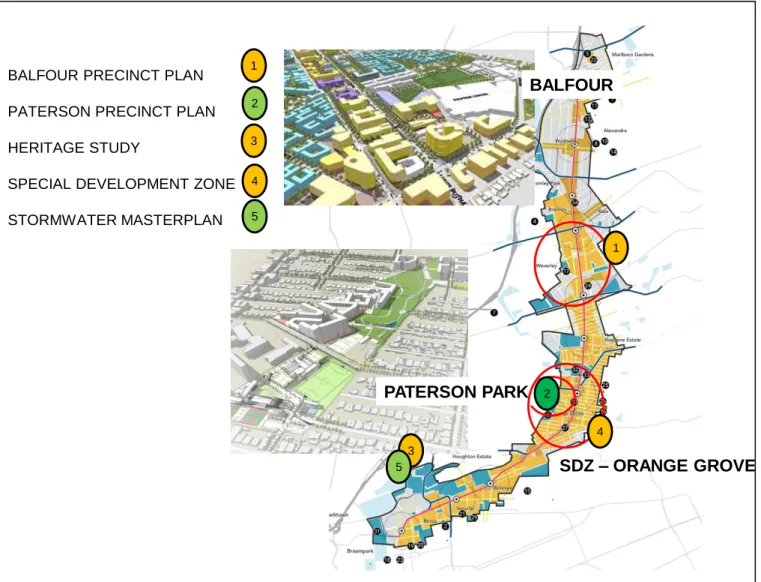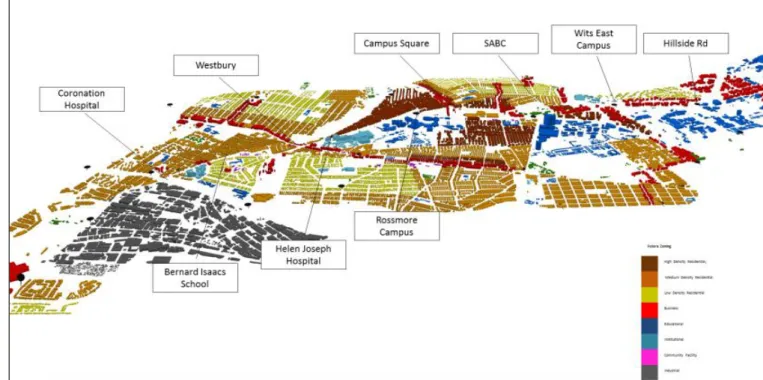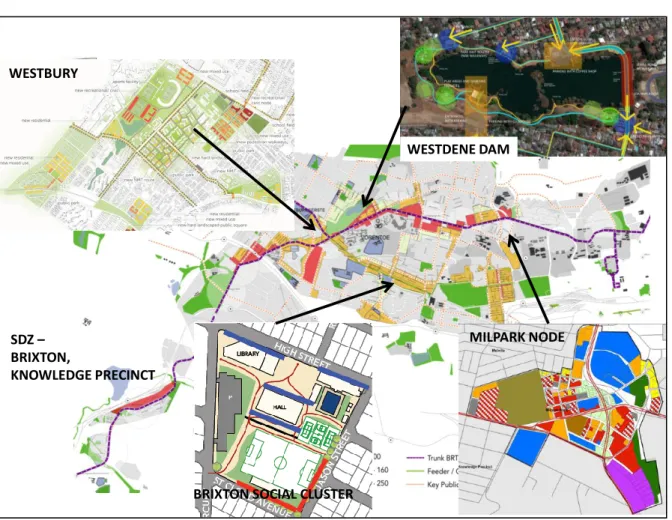BACKGROUND
7| Joint grant funding represents a significant proportion approximating 40% of the City's annual capital budget. Future reviews of the BEPP will report on progress on the indicators discussed to illustrate successes and areas requiring more work. a) Spatial Planning and Project Prioritization.
CONFIRMATION OF ADOPTION
STRATEGIC REVIEW OF THE BUILT ENVIRONMENT
The City has the largest economy in the country and contributes about 17% of the national GDP and about 47% of Gauteng's economy.
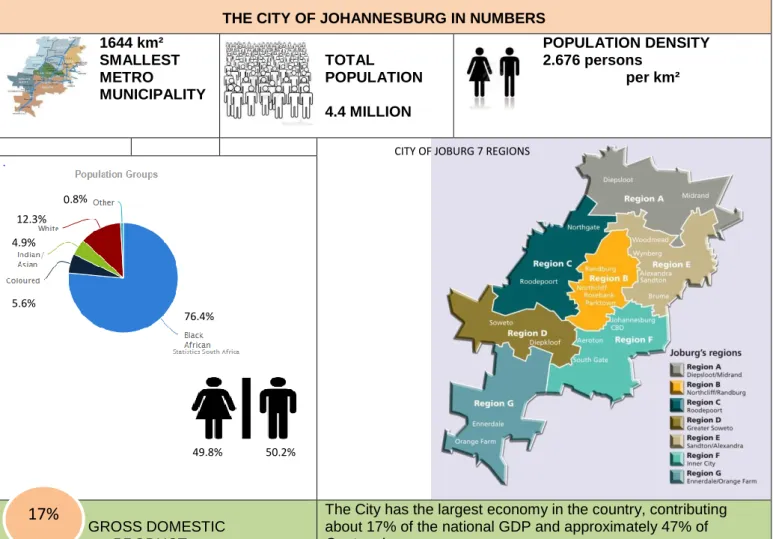
SPATIAL TARGETING
L ONG T ERM V ISION
Each program formulated a number of sub-programmes in support of the outcomes and principles embedded in GDS 2040. Water improvements to install a pumping station, a 2.5 Ml tower and 9.7 km of water pipelines are in the design phase.
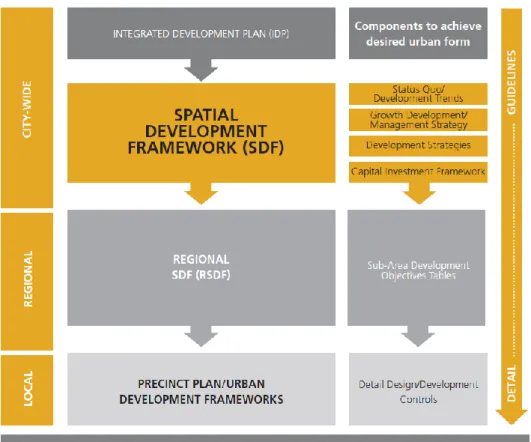
S PATIAL D EVELOPMENT F RAMEWORK
- Transformation Agenda: towards a spatially just City
- Spatial vision: a compact polycentric city
- The Spatial Framework
- Implementing the SDF: Capital Investment and Growth Strategy
- Capital Investment Focus
The transformation area is a key focus area of SDF in terms of future growth. Second, the implementation of the SDF will depend on capital investment in infrastructure that supports growth directions and ambitions for future development.
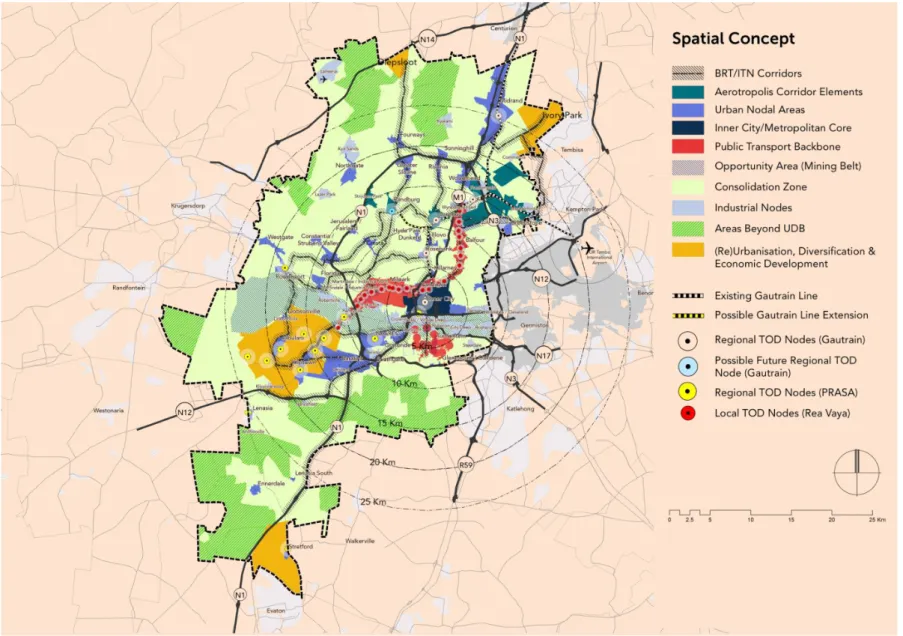
I DENTIFICATION OF U RBAN N ETWORK , I NTEGRATION Z ONES AND H UBS
- Central Business District (CBD)
- Integration Zones
- Louis Botha Corridor
- Empire Perth Corridor
- Turffontein Corridor
- Mining Belt
- Urban Hubs
- Jabulani Hub
- Alexandra Hub
- Marginalised Areas
- Addressing Marginalisation through (re)urbanisation
- Informal settlements
- Backyard units
- Nodal Strategy
- Mixed-Use/Key Urban Nodes
- Industrial/Specialist Nodes
The corridor is located in the central eastern area of the city, mainly in the administrative region E. The Louis Botha Strategic Area Framework is the city's guide for the short to medium term development of the corridor. Turffontein is located south of the CBD on the southern edge of the mining belt. The Turffontein Corridor is different from the two corridors described above.
The interventions proposed in terms of the Strategic Area Frameworks for the Corridors can act as catalysts for a broader intervention within the mining belt zone. The relevant Zone is the location of the last remaining large tracts of undeveloped land in the east of the City. The potential to negotiate public/private partnerships for the development of the area is higher than in other areas within the City.
Diepsloot: Improve links to the nearest major regional center - the Centurion hub, and deliver improved services and infrastructure, economic development and growth of mixed hubs in the agglomeration.
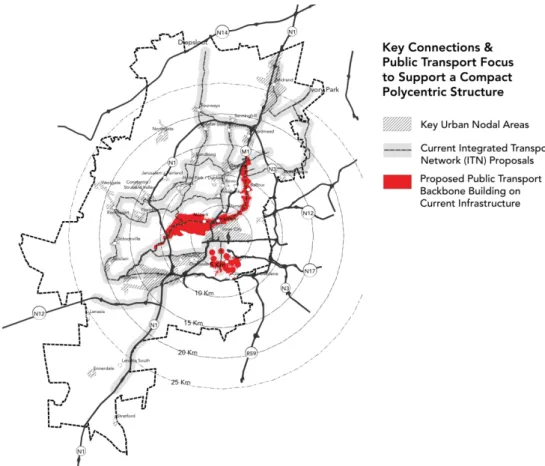
E CONOMIC D EVELOPMENT S TRATEGY FOR THE C ITY OF J OHANNESBURG
- Key Economic Strengths and Some Key Economic Challenges
- Foundations of an Economic Development Strategy for Johannesburg: Transformation
The Plan has the 2011 Joburg 2040 City Vision as its foundation and is informed by the City Economic Development Strategy of and the City Economic Transformation Policy Framework of 2011. The Plan is also informed by National and Provincial imperatives, policies and plans, including the National Development Plan and New Growth Path . Ensure effective research, intelligence gathering and investment decision-making criteria in identifying and prioritizing city expenditures.
Includes community co-production of goods and services for the City to create jobs and income and grow new business.
CITY-WIDE CATALYTIC PROJECTS
COORDINATION OF SIPS
SIP2 - the Durban-Free State – Gauteng Logistics and Industrial Corridor
SIP 7 – Integrated urban Space and Public Transport Programme –
Apartments and warehouse upgrade Upgrading apartments around Joburg Fleurhof Mixed development (bulk and internal infrastructure). Provision of bulk infrastructure including grid connection to specifically the following: Water, sewerage, roads and stormwater management systems. Formalization of informal settlements within the City of Johannesburg Administration Regions A-G Land purchase Land purchase for properties in Princess Plots,.
Lufhereng Mixed Development The project involves the provision of bulk, link and internal roads, sewerage, water and stormwater to the Doornkop Greenfields project (a mixed housing scheme consisting of 25,000 subsidies) implemented by the Gauteng Department of Housing in terms of its incremental housing program is implemented. Nancefield Station Precinct Housing Redevelopment of existing flats and construction of additional flat accommodation and provision of bulk infrastructure associated with the development Selkirk Social Housing Development of 300 medium density housing within.
MEGA PROJECTS
THE VALUE OF PROGRAMMES AND PROJECTS AND PROJECTS BY DIVISION
- I NNER C ITY
- L OUIS B OTHA C ORRIDOR
- E MPIRE P ERTH C ORRIDOR
- M INING B ELT C ORRIDOR
- T URFFONTEIN C ORRIDOR
- J ABULANI
- A LEXANDRA H UB
- Non-infrastructure related interventions in the Alexandra Hub
CORR - Louis Botha Corridor of Freedom Traffic Impact Assessment (TIA), Stormwater Masterplan en New COnstriction and Upgrading Renewal Corridors of Freedom Intervention ORANGE GROVE E Regionaal. Louis Botha - Coproductiezone voor sociale interventies Vernieuwing Corridors of Freedom Intervention ORANGE GROVE E Regionaal. CORR - Perth Empire Corridor of Freedom Traffic Impact Assessment (TIA), Stormwater Masterplan en New Constriction and Upgrading Renewal Corridors of Freedom Intervention WESTBURY B Regional.
Perth Empire Corridor Social Development Co-Production Zone Renewal of Freedom Intervention Corridors (Social Development One Stop Center) Renewal of Freedom Intervention Corridors. CORR - Turffontein Corridor of Freedom Traffic Impact Assessment (TIA), Master Plan for Rainwater and New Construction and Improvement of Renewal Corridors of Freedom Intervention Renewal Stormwater.
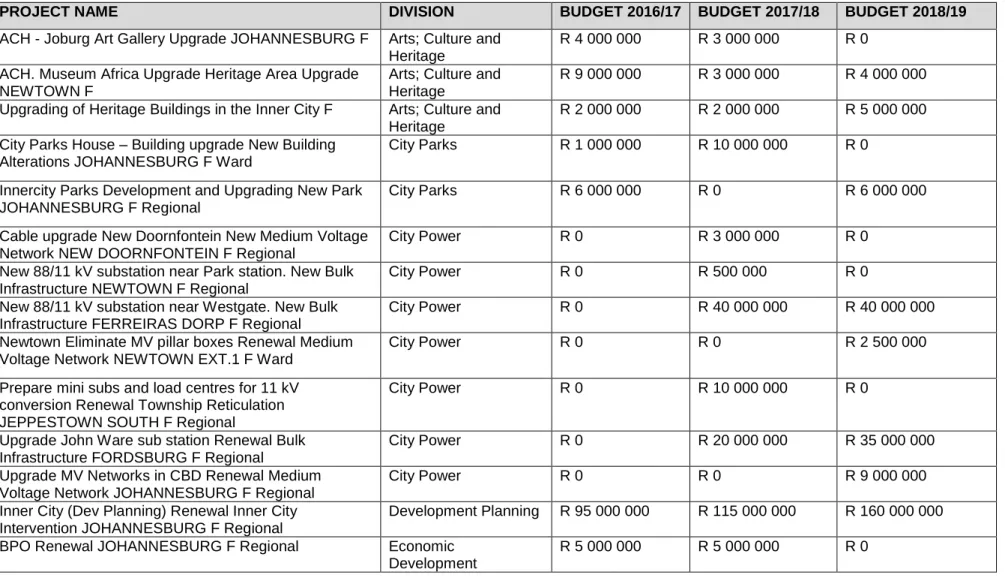
THE APPLICATION OF GRANT RESOURCES BY GRANT PROGRAMME AND PROJECT
- I NNER C ITY
- L OUIS B OTHA C ORRIDOR
- E MPIRE P ERTH C ORRIDOR
- T URFFONTEIN
- J ABULANI
- A LEXANDRA H UB
A major infrastructure coordinator, the Alexandra Renewal Project, in conjunction with the Administrative Region's E-Bureau, is arguably the most important government agency conducting non-infrastructure-related interventions in the Alexandra Integration Zone.
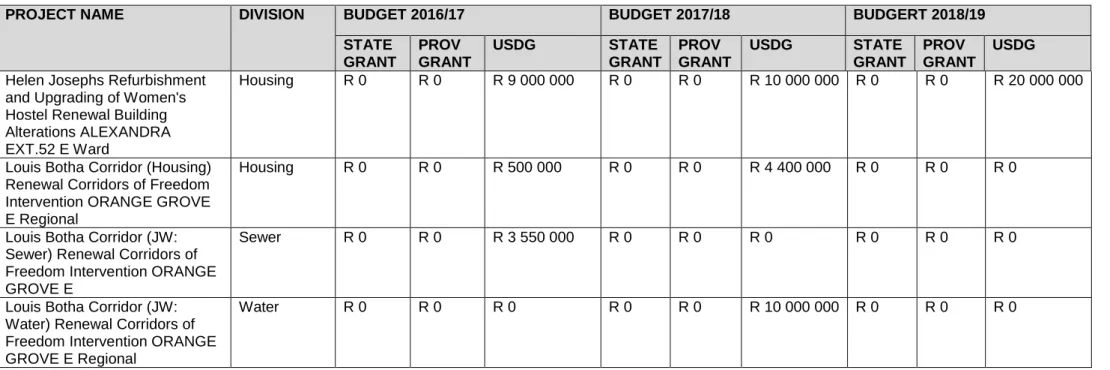
PROPOSED TIMEFRAMES FOR IMPLEMENTATION OF CATALYTIC PROJECTS AND PROGRAMMES
- C ENTRAL B USINESS D ISTRICT
- Urban Development Zones
- C ORRIDORS
- Special Development Zones
- Land Strategy: Corridors of Freedom
- J ABULANI
- I NTEGRATION Z ONES
The number of social services proposed in the corridors will take into account the increased density and expected population growth of the city. As part of the city's effort to accelerate development within the Corridors of Freedom, the city's Development Planning Department through the Land Use Management Directorate is developing a tool that can be used in reviewing development applications specific to the corridors. However, the city has already started a land acquisition process to acquire strategically located properties within the three corridors.
This allows the JPC to purchase on behalf of the City at market-linked values on a willing buyer/seller basis. The City is currently working on a strategy to increase the number of social and affordable housing units within the Corridors – releasing land for social housing establishments is part of this strategy.
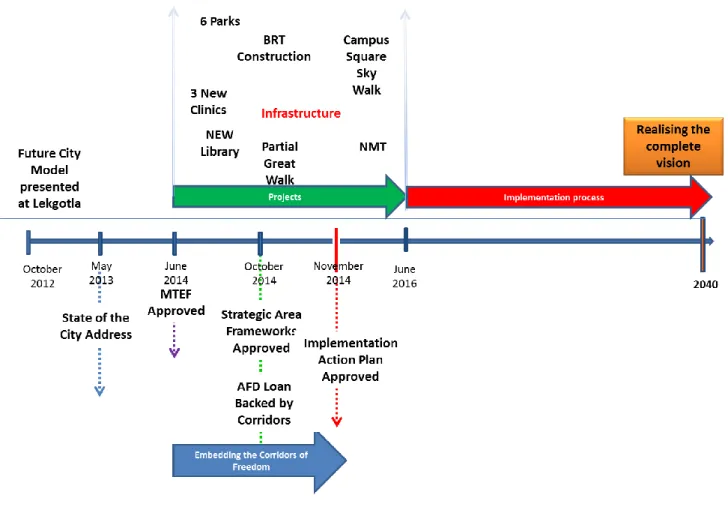
URBAN MANAGEMENT
POSSIBLE INCENTIVES AND INSTITUTIONAL MECHANISMS IN CORRIDORS
THE CITY OF JOHANNESBURG TRANSPORT MANAGEMENT APPROACHES
M ANAGE C ONGESTION , T RAVEL D EMAND AND P ARKING
- TDM measures
- Parking management measures
- Traffic management and Intelligent Transport Systems
- Park and Ride Strategy
Ridesharing or "liftclubs" are particularly suitable for commuters who live close to each other, share a common routine destination and who have limited access to public transport. Changing employer policies such as introducing variable and flexible working hours, working from home and telecommuting, increased use of video conferencing and teleconferencing, reducing the availability of free or reduced cost parking for employees, offer employees the option of ' a public transport allowance instead of paid parking and the provision of pool cars for work trips as opposed to a private car subsidy scheme and the provision of cycling facilities at the. Develop comprehensive plans to address on-street parking in the CBD and all major nodes.
The proposals will be submitted for public comment and the finalized proposals will be incorporated into the Zoning Scheme if and when legal challenges to the scheme are successfully addressed. More park and ride facilities will be introduced, also for the use of ride sharing schemes.
P LAN AND R EGULATE THE T RANSPORT S YSTEM
- Data Collection
- Integrated Transport Planning
- Administration of Operating Licence applications
The goal is for private operation through partnerships with the private sector, and to use existing underutilized parking spaces rather than developing new sites. While the administrative and issuing function may remain in the provincial sphere, the responsibility for making the actual decision on each application under law remains with the city's transportation department. There will be a proper decision support system and database so that the required supply of vehicles in each mode can be compared in terms of the ITNP with the licensed supply (according to the Operating License Administration System - OLAS of the PRE) per each public transport route across the road.
Standard procedures will be developed to evaluate each application for an operating license coming from PRE, using the database as well as consultation with stakeholder structures. These will cover the conditions that will be attached to operating licenses for various modes of transport from minibus taxis to tuk tuks.
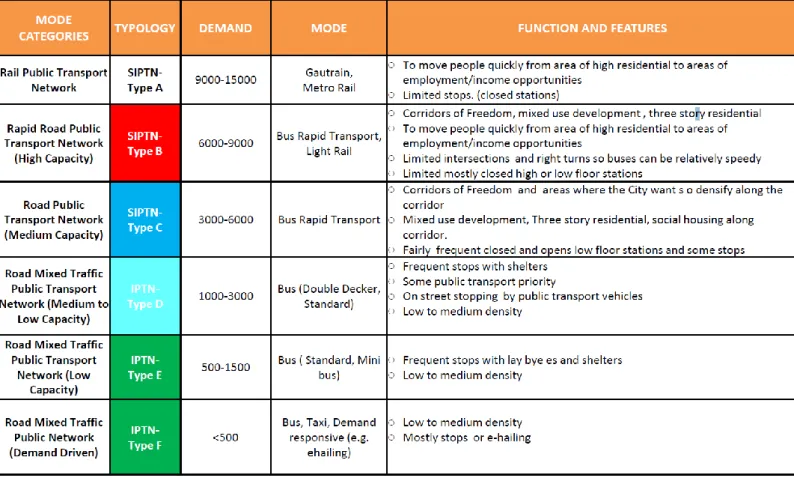
INSTITUTIONAL ARRANGEMENTS
L EGISLATURE
T HE E XECUTIVE
Group Corporate and Shared Services (Human Resources, Labor Relations, Office of the Chief Information Officer/Information Technology. Group Strategic Coordination and Relations, responsible for overseeing, coordinating and managing key Group policies (including the Integrated Development Plan), strategies and tactical plans to ensure efficient and optimal service delivery The cluster approach aims to align city programs around a set of outcomes outlined in Joburg 2040 and the Mayor's 10 priorities to integrate service delivery.
Ensuring overall coordination and coordination of service delivery between departments and municipally owned entities within the cluster. Advising the Mayor's Committee on progress in the implementation of service delivery programs in the relevant clusters.
INSTITUTIONAL ARRANGEMENTS FOR CAPITAL PROGRAMME MANAGEMENT
T HE C APITAL B UDGETING P ROCESS
Answers to these questions, combined with the location of the project, are then used to prioritize the projects in question. The two budget management committees assess and comment on the departments' and units' business plans, including proposals for capital budgets for the medium-term expenditure framework. This interaction helps the administrative leaders of the city to make informed decisions about the allocation of the budget at another Budget Lekgotla.
It is through this process of capital budgeting that the city's strategic policies outlined in the GDS, IDP and the priority transformation areas, as well as the practical requirements of the entities and departments are summarized in a list of capital projects that the city will undertake over the period of three years. The implementation of the consolidated infrastructure plan, which aims, among other things, to improve the coordination of asset management in the city of Johannesburg.
SUPPLY CHAIN MANAGEMENT AND PROCUREMENT PLAN
101 | P a g e These departments are provided with an opportunity to present their own critical projects from the list of projects captured by them at the JSIP which may differ from the priority list generated at the JSIP so that they can be considered by the Budget Lekgotla for approval and implementation in the third fiscal year of the financial year of the Medium Term Expenditure Framework (MTEF). When the Budget Lekgotla, which represents the legislative and executive branches, pronounces on the tentative draft of the capital budget, a draft list of capital projects is prepared from the JSIP. The Preparatory Technical Budget Steering Committee and the subsequent Budget Steering Committee (BSC) were established in accordance with the municipal budget and MFMA reporting regulations.
The Directorate assesses the financial performance of the entities and departments, reports on financial progress and makes recommendations on spending patterns and future allocations of funds. The establishment of the Engineering Center of Excellence in the Office of the Operations Headquarters which will provide support to existing engineering capacity.
PARTNERSHIPS
Housing market segmentation Annual change in the number of completed subsidized rental housing units within the primary and secondary network and within integration zones. Annual increase in the number of completed subsidized rental housing units within the integration zones until reaching the optimal level Annual increase in the number. Annual increase in the number of completed rental apartments in private ownership within the integration zones until the optimal level is reached.
Percentage of change in total kilometers of dedicated footpaths and cycle paths in relation to the length of roads within the primary and secondary network and within the integration zones. Increase in business opportunities Four-year percentage change in the total market value of all commercial real estate in the integration zones of the primary and secondary network.
